Media | Articles
Values for GM’s full-size trucks (1988–2002) are still rock-solid
Like a rock
I’m six years old again. I’m in my grandma Squeak’s living room, playing with Hot Wheels on drab brown carpeting.
I was as strong as I could be
In the kitchen, Grandma is making some sheet-pan cookie concoction. An early 1980s TV set hums before me. Onscreen, a tableau of concentrated, unfiltered Americana flashes by.
Like a rock
Marketplace
Buy and sell classics with confidence
The people onscreen congregate and toil around some boxy Chevrolet trucks. A contractor shows some architectural plans to two other folks with the documents unfurled over the truck’s slab-like hood.
Nothin’ ever got to me
A blue shortbed crashes through slime and mud. A rodeo cowboy jumps in his crew cab to escape a charging bull. A towhook snaps taut, erecting the structural framing of a barn. I’m transfixed.
Like a rock!
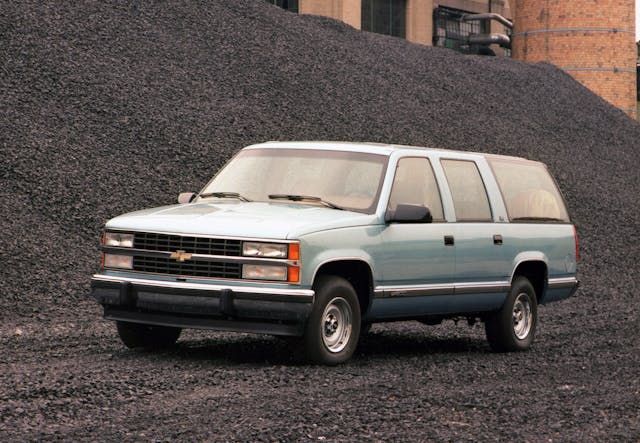
I think a sizeable portion of the millennial and Gen-X population has some memory sequence parallel to mine. All you’ve gotta do is queue up Bob Seger’s gravelly, rawhide anthem to trigger a thousand-yard stare. Chevy’s tremendously successful “Like a Rock” campaign that ran from 1991 through the early 2000s sold a lot of trucks. Judging by Hagerty Price Guide values, it continues to do so today.
General Motors’ full-sized trucks and SUVs produced between 1988 and 2000 (2002, if you count the HD family) have long existed in a liminal space in collecting. The GMT400 trucks, as they’re collectively known, were positioned as direct evolutions of the ultra-popular Square Body Chevy C10 and GMC Sierra, and they exited the scene just as full-size SUVs were beginning to take over every school carpool line. Now, surging interest and values in these trucks has us humming one of Mr. Seger’s biggest hits as we investigate what might behind this gradual rise to collectibility.
In the past three years, values of Chevy GMT400-series trucks have increased by 63 percent. No coincidence, calls to Hagerty agents for quotes on insurance for the trucks have increased 58 percent in the same period. For GMT400 GMC trucks, values are up 52 percent, with 53 percent growth in insurance quotes.
It’s no surprise the Chevys bring more money than the GMCs, even if they are the same under the skin (and even the skin ain’t that different). Enthusiasts naturally prefer certain body styles, as well. For instance, the latest Hagerty Price Guide pegs a 1988 Chevy K1500 4×4 two-door fleetside short-bed pickup at $15,600 in Good (#3) condition. That’s nearly 80 percent more than three years ago. And perhaps because so many of these trucks lived exceptionally hard lives, collectors are paying a hefty premium for the finest examples. Find an Excellent (#2) ’96 short-bed with a 255-hp small-block V-8, and you can expect to shell out more than $35,000.
If you’re thinking that sounds like a lot of coin for a mass-produced truck churned out more than a quarter of a century ago, we’re with you. But the rise is not without precedent.
First, remember that the long-lived Square Body generation of trucks appreciated early among insurgent truck values. Caveman simplicity, stout dimensions, testosterone styling, and a cavernous engine bay transformed these vehicular cudgels into street rods, backwoods 4×4 brawlers, cherry boulevard cruisers, weatherworn workhorses, and everything in between. People love these bricks because they’re brutish and simple.
It’s 1988, and here comes the GMT400. Computer-aided design took on a larger role than it ever had before in the design and production of the new truck. Still ludicrously boxy by today’s standards, this generation previewed the slow trudge toward today’s curvaceousness, with semi-rounded edges, flush fittings, and sedan-style doors.

The biggest changes hid underneath the new sheetmetal. Four-wheel-drive K-series trucks packed a new independent torsion-bar suspension, and ABS made its first appearance on GM trucks. Compared to the relatively floppy and rust-prone Square Body, the new GMT400 platform incorporated extra galvanized steel and a fully welded frame featuring a boxed front section for extra rigidity.
Powertrain options are stout, too. The base engine is a 4.3-liter Vortec V-6 with enough torque to serve as basic work truck and transportation. Most of the more expensive GMT400s come to market with one of the V-8s, whose displacements started at 5.0 liters and spiked to a mighty 8.1 for the HD haulers.
All this relative modernity, while still remaining rugged, the semi-simplistic mechanicals, and the masculine design—in the long run, the combination proved to be the best of both worlds. Hagerty Price Guide editor Greg Ingold has owned three GMT400 trucks over the years, and he’ll be the first to sing their praises.
“I appreciate how GM refined the idea of the truck,” he says. “They made them nicer to drive compared to the Square Bodies. They’re nothing like the near-luxury trucks of today, but they’re not too utilitarian.
“The GMT400 is sort of that goldilocks truck. GM got it just right, and the people who own them seem to appreciate them for that reason.”
By and large, the GMT400 was considered just an old, used truck for the better part of 25 years, and the values reflected this. But, for those of a certain age, the love never faded.
There’s a lot to love. Between no-frills, never-gonna-break work trucks and the stylish, high-performance 454 SS, the GMT400 fills quite a few niches. (The 1990–1993 1500 454 SS is the most valuable of GMT400s, with Condition #2 values creeping close to fifty grand.) When they do break down, parts supply is absurdly comprehensive and you can fix them with basic tools. Just ask Hagerty editor-at-large Sam Smith how simple and lovely his old 1500 Cheyenne was.
It gets better. The GMT400’s blend of modernity and old-world aesthetic attracted customizers and hot-rodders like Carlisle does Corvettes. The “Sport Truck” subgenre of hot-rodding erupted while the truck was new, with big names like Boyd Coddington and Belltech creating “static dropped” customs with neon paint and vibrant graphics.
And, like so many “vintage” trucks, this one seems to appeal to a broad swathe of collectors. Plenty of millennials and Gen-Xers are showing interest, but one in every three people calling us about these trusty trucks is a baby boomer.
That wide interest, along with the stunning appreciation we’ve seen for trucks and SUVs of all stripes, leads us to believe that the rise of GMT400s is no fad.
And now, since you’ve made it this far, we’ll give you some TV time:
Check out the Hagerty Media homepage so you don’t miss a single story, or better yet, bookmark it.



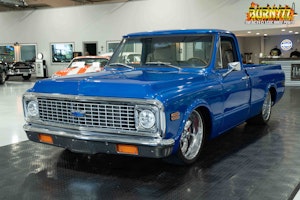
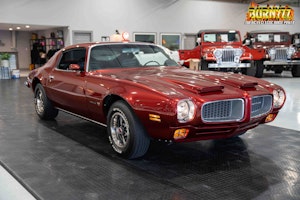


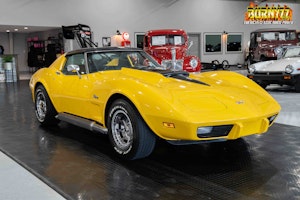



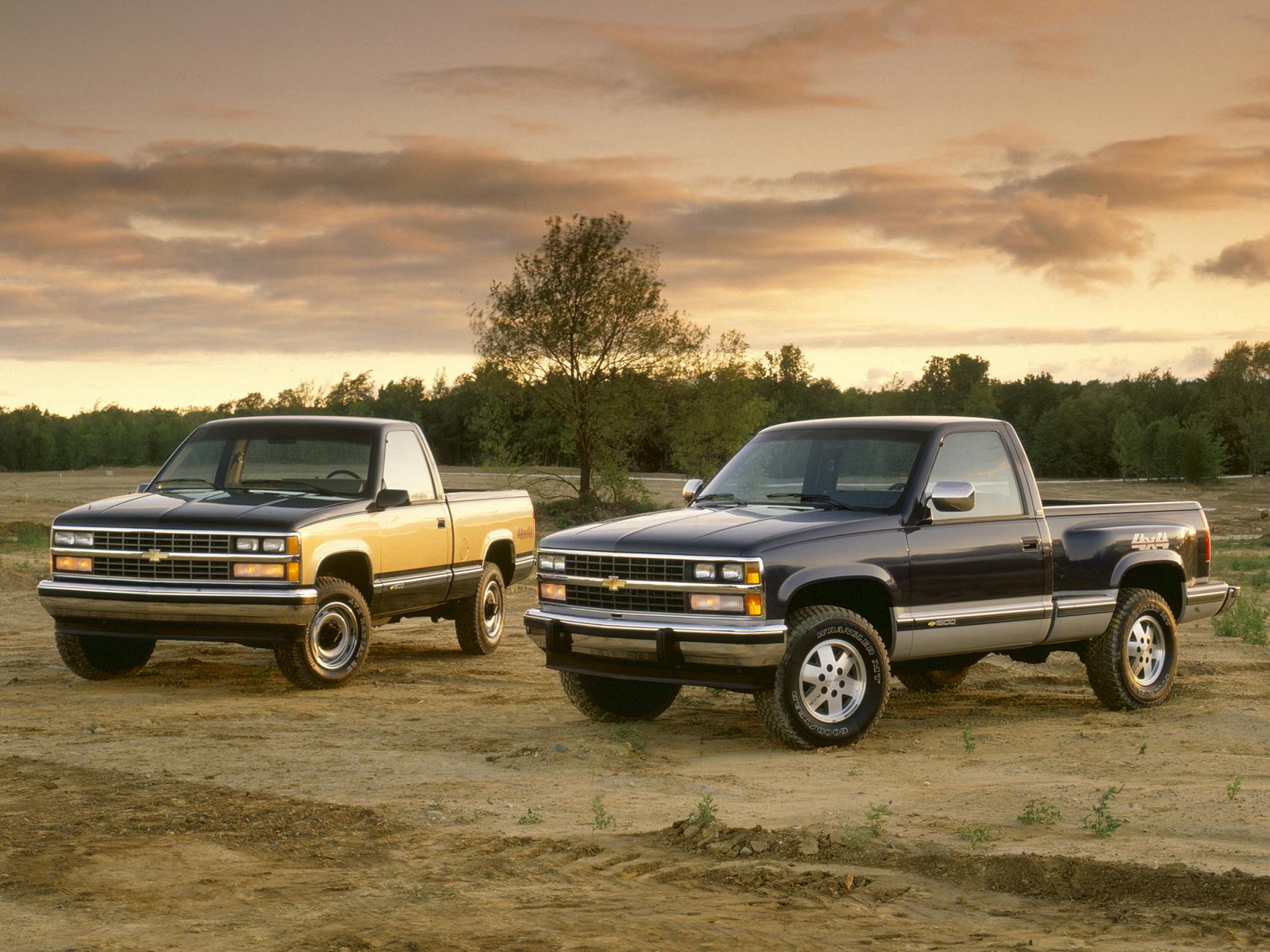
I bought my 94 full size Blazer to serve as a truck – and even though it has moved into collectible range it still serves the role of truck – full of tools, not pampered, and north of 200K miles. These things are generally bullet-proof which is a big part of the appeal
Here in Baja My 92 blazer is the cat’s meow 😸
My 94 fill size is at 350k and still tows my 6k# boat regularly. I call big red “proven”
I think your example is stated perfectly and I totally agree. These trucks were purchased to be abused. Many have become work trucks. Throw your tools in the back, go to work, make money in your trade and drive home safely (and mostly reliably). It’s also a time when GM started to “value Engineer” (Cheap out) parts. So certain parts will always die out long before the truck does. From a pure collectible standpoint, like “Sunday driver status” it would be difficult to find that diamond in the rough. The diamond in the rough would like the 2000 4×4 with like, oh 5000 miles on it. I don’t think any of those exist because these trucks were built for a purpose. Also, up here in New England, the 4 x 4 is a very desirable feature. Right now I have a 2003 Blazer that won’t go into 4 wheel drive. Do you know what you call a 4 wheel drive Blazer that won’t go into 4 wheel drive in a snow storm? “Useless”. Worse than a front wheel drive car. Also, up here in New England, these trucks are desired for their 4 x 4, which makes them excellent in the snow. The major downside is the road salt rots these things out. So, they may be collectible as long as you find a survivor that never lived in the snow belt.
I like to think that I personally had a hand in why these trucks were so good. We had these trucks when they were new as work trucks. We would drive the crap out of them. The old ones could be destroyed by over revving, the new (1988) ones had rev limiters. The transmissions on the old ones would go where you put them, allowing you to float the valves in first gear, the new ones would automatically shift from first to second if you held it long enough. Things like that make a truck last a long time.
Gen X is missing from the graph… so it isn’t close to 100%.
These still get posted for sale in the general used car ads, but also appear in the “classic car” listings. I expect 5-7 years from now they will be scarce in the general ads.
These trucks have had a following since new. The advertising was highly memorable and the aftermarket support was immediate. I own two currently (classic original farm truck driver and a not-on-the-road bush 4×4) and have been involved in parting out 4 others in the last 2 years (all beyond saving for the road).
Prices range wildly where I live and often don’t match with condition. I intend to buy at least one more for the road since I love the 4×4 but fixing my bush truck is illogical vs. just buying a decent example. I’m also not opposed to a circa-1990 lowered (no c notch) period build.
Lots of stuff is available for these true, but some silly things have been tricky at times the last few years. Dashboard bits and various switches can be a fail point as many of the parted-out trucks most of this stuff was broken, cracked, etc.
A fair number of the for sale in my area are younger people that got in over their heads with something they though would be cheap and easy to get on the road that needs 1000s of dollars in brakes, cab mounts, rockers, etc. to safety. Also watch out for rust above the windshield, because the galvanized coating on the box sides you can have nice looking panels on boxes that are rotted out underneath –caps took off at this time too so the inside of the box can look great even if the structural rails underneath are bad.
Have fun. I recommend them.
I bought a ‘99 GMC C3500 dually two years ago (125k miles, 7.4L). Used it the last two summers to tow a fifth wheel trailer, what a great truck! Excellent visibility compared to new trucks and very good payload capacity. Extended cab has plenty of space to get four of us to the camp site comfortably. If the engine blows I’d seriously consider putting in a new 502 vs. buying a new truck.
Great choice of engines, however don’t discount the connect and cruise packages available as there are horsepower and torque ratings above the 454 and 502.
These engines also offer a very strong bottom end for long term use or upgrades later.
That Rat motor will only need a top end job at about 200 K, this can be easily done without removing the motor or even the hood!
To me this era was the perfect size truck. Not too big, Not too bulky and Not too over the top. Today many of these trucks are now Plastic chrome laden over done messes.
I was just never a mini semi nose fan.
I used to drive a truck like on the Rockford Files A GMC in the same colors only long bed. I loved that truck and wish I could find one like it today in low miles.
The key to the Chevy trucks are they were durable and the parts were and still are fairly easy to get and fit.
I purchased my first ever new vehicle in January 1991. I ordered a 1991 Chevrolet Silverado Short Bed Fleet-side 4×4 5.7L with every option at the time in the light blue color. I still own this truck today as it just turned 96k original miles. This beautiful truck still turns heads when ever and where ever I go for fuel. The only thing not stock to the truck are the 2009 Z71 Tahoe wheels and Bridgestone tires and the signature one piece muffler with twin tipped tail pipes, waterpump and radiator. Still run the original R12 ice cold A/C system too. Always garaged, parked on carpet. Love this truck even today
My ’95 Silverado 1500 is still going strong at 280,000 miles. Still my preferred driver while my ’14 Silverado sits with only 39,000 miles driven. I actually learned to drive in a 1952 Chevy 1 1/2 ton following my dad around the wheat field when I was 10. I belong to a long line of Chevy owners and have a picture of my dad and his ’32 Chevy school bus.
1988 GMC 3500, originally built in Canada for Grumman Corp. as a Chassis incomplete. I purchased in 2002 and set out to rebuild the entire truck. It hauled a large truck camper all over the Country and Canada. 630 miles of gravel on the Trans Labrador , around Lake Superior, Key west, FL as well as doing duty as an everyday utility vehicle. Twelve round trips to Newfoundland from NYS. I always felt confident that I could repair anything that might arise while on the road with basic tools. I own a 2017 other brand luxury truck. If I had to let one go, it would not be the GMC.
I have a 2002 Chevrolet Avalanche, the design is beautiful and ahead of its time. Mine looks new and I love it.
I love my 97 Cheyenne. Extra cab, long bed, heavy duty suspension, V8, automatic. Great daily driver that doubles as a reliable work truck for all my projects around the house. I take good care of it, and it takes good care of me!
It’s really to bad. If GM had been willing to spend $20 maybe $30 extra dollars a ton on the steel these trucks would have truly been legendary. As it is, most of these trucks turned into rust buckets, at least in states like Michigan where the state is trying to turn the Great Lakes into salt water bodies.
It would be interesting to hear from tow-truck operators who hooked up GM trucks from that era with hydro-formed frames to hear of their experiences on towing vehicles with that then-new technology. For the purposes of tow-truck operator liability, I have heard that operators always made sure that the owner of the vehicle to be towed was the one making the final hook-up. Maybe an * should be used in this article to acknowledge the period of these defective frames, hence values.
Not sure what Don is talking about. I have worked at a Chevy dealer since 2004. These trucks were a staple of our work then. Only frame problems were when they took a hard angle front hit, that would bend a Chevy, Ford or Dodge frame. Pitman and idler arms wear out. But no frame problems. I currently own 3 of these trucks, a 90, 97, and 99. Have owned others and my immediate family currently owns 5 more. I have literally worked on thousands through my career, and know nothing of this supposed “front frame problem”. I’m also good friends with the 40 year tow driver at the dealership.
I have never known anybody who has had a frame problem with one of these. I’ve put a pretty strong whoopin on it over the years, and the previous owner has had it airborne a few times judging from the suspension damage when I got it
https://www.wardsauto.com/news-analysis/gm-truck-frames-taking-flexibility-too-far
GMC/Chev truck pride of ownership of this time period clearly runs deep. In case you missed it or forgot about it, have a look at this Ward’s Auto article from 1999.
That article is about transport trucks tying down the next generation GMT800 trucks the same way they tied down the GMT400 trucks. We are talking about GMT400 trucks in this article.
The GMT800 truck frames did bend in collisions easier than a GMT400. However under normal use (or even heavy farm use), or normal vehicle recovery the GMT800’s didn’t have a problem. If you use hydraulic rams to secure anything improperly (like in that article) things will bend.
I can tell you lists of problems with both generations of trucks. I have made a good living repairing them. But I call a spade a spade, and GMT400 trucks do not have a problem with the front of the frame.
The dealership I work at has a 1992 GMT400 tow/recovery truck. It has a very heavy tow bed on it. After 25 years of being a tow truck and 280k miles it has a cracked frame. But it is cracked behind the cab from constantly being overloaded.
You may find different long term results from rust. In SW Utah we don’t have big rust problems.
You should’ve challenged whomever told you that nonsense about tow drivers making the customer do the hookup, they were insulting your intelligence.
No GMT 400 came with 8.1. Biggest was 7.4
The 2001 and 2002 ‘Classic body’ 3500 HD had the 8.1. Very rare to find one but they had one.
Except the 2002 C3500….still a GMT400 variant.
I have had one since I bought it new in 02 has a 8.1 engine now with 103000 mi.
Love old chevy trucks. Now I have a 93′ s10 2.8 v6, 5 speed with 77,000 on it. Ex cab, short box. 30 mpg. I love it.
My 93 Chevy short box is my show car with 80,000 miles and everything original with original paint job. It is still a head turner we’re ever I go.
i have a 93 gmc long bed with a chevy grill i bought 8 years ago with no engine or trans for $500 i put a 1975 454 and th350 in it and some 96 impala SS wheels . i use it to tow my 20 foot car trailer. it is a really awesome truck it runs and rides great. 😁